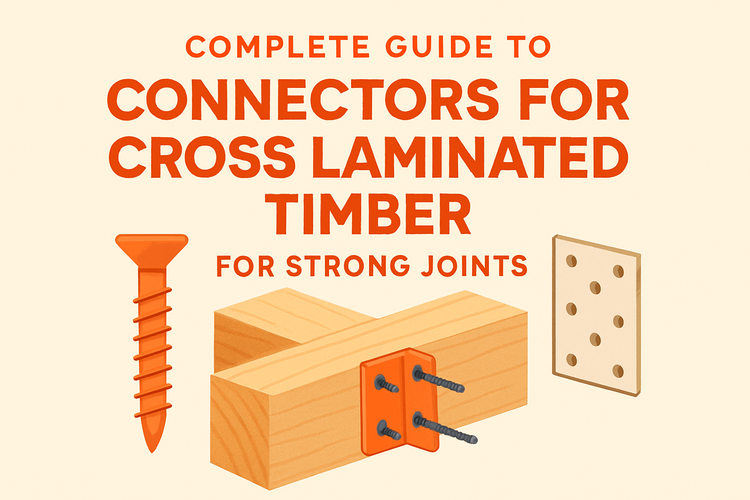Complete Guide To Connectors For Cross Laminated Timber For Strong Joints

Choosing the Right Connectors for Cross Laminated Timber
Selecting the right connectors for cross laminated timber (CLT) is crucial to ensure the strength and long-term performance of any timber-built structure. CLT's unique strength and dimensional stability allow for the use of highly specialized fasteners and connectors tailored for large-scale engineered timber assemblies.
CLT systems benefit most from engineered connectors designed with loads, moment resistance, and multi-directional forces in mind. Investing in components made specifically for CLT builds will result in more reliable load transfer, easier assembly, and long-term structural integrity. Visit our selection of connectors for cross laminated timber to explore your options.
Engineered brackets such as concealed beam hangers and screw-reinforced angle brackets offer strength under multiple load directions. These connectors allow flush mounting and minimal visual disruption, important in exposed timber constructions. Moreover, they work in synergy with high-strength self-tapping screws and nails specifically designed to pair with CLT’s layered design for maximum effect.
One key aspect in selecting connectors is understanding the specific stress factors of the project — horizontal loads for seismic zones or vertical loads in multi-storey structures will dictate different configurations. Precision-designed brackets, plates, and anchors make versatile high-strength connections possible even in complex architectural forms.
Load Distribution Techniques with Angle Brackets and Plates
Angle brackets and steel plates reinforce structural points in CLT by distributing loads efficiently. These connectors are essential in bracing and rigidly connecting faces in multi-panel builds.
Angle brackets provide support against shear and uplift forces, particularly when anchoring CLT panels to foundation elements. They are widely used in applications ranging from wall-floor junctions to T-joints. By choosing corrosion-resistant, powder-coated, or stainless steel models, builders also enhance the longevity of timber connections exposed to weather or high humidity conditions.
Large flat plates and concealed mounting setups offer excellent axial resistance in planes where panels connect directly. Selecting heavy-gauge brackets with multiple fastener options enhances the lateral load resistance, making it easier to meet design codes. Browse high-strength angle brackets that are tested for structural performance under demanding conditions.
Properly spacing such connectors, setting screw angles, and matching them with approved fasteners ensures cohesive performance. Many brackets now come with pre-engineered load tables and certifications, making engineering calculations faster and more accurate for both residential and commercial uses of CLT.
Secure Base Connections with Post Bases and Restraint Straps
For CLT buildings, anchoring wall and post elements to the foundation is critical. Post bases and restraint straps offer both structural stability and assistance in load continuity between ground and upper components.
Post bases elevate timber ends off the ground to prevent moisture damage while transferring axial loads into the concrete or masonry base securely. Adjustable brackets that align with structural bolts and dowels are perfect for accommodating on-site discrepancies while retaining erection speed. Especially in seismic-prone areas, the hardware should accommodate uplift and lateral movement without compromising the timber.
Post base systems include models for both surface-mounted and embedded applications, providing options for interior beams or outdoor applications. In taller structures, base connectors with moment-resisting capacity are ideal for supporting large lateral forces.
Complementing this support, restraint straps anchor CLT wall nodes, roof plates, or headers back to the structure’s core strength. Positioned diagonally or horizontally, these straps lock structural members into one load path, transferring tension and protecting against shifting in wind or seismic activity. You can find high-quality restraint straps for a variety of applications in large engineered timber builds.
Fastening Systems That Work Seamlessly with CLT
Fasteners are the unsung heroes in timber construction. In cross laminated timber systems, the wrong choice of screw or nail can compromise an otherwise perfect connection plan. That’s why pairing connectors with compatible fasteners is vital for strength and safety.
CLT’s density and layered composition mean that long-thread screws with high withdrawal resistance offer superior performance. These fasteners create compression between panels and connectors, often replacing traditional bolts by providing repeatable, consistent performance. Special helical threads minimize splitting and bore into CLT layers without needing pilot holes.
Choosing the correct length and head design ensures optimal embedding of face plates, hangers, or straps. Anti-corrosion finishes enhance durability, especially in semi-outdoor spaces like eaves or ventilation towers. We recommend exploring purpose-built screws and nails that meet modern CLT construction standards and simplify installation time without sacrificing strength ratings.
Many engineered connectors for CLT now come with installation kits or guides suggesting exact screw types and counts. This contributes to more consistent structural results throughout comprehensive mass timber projects like schools, halls, or mid-rise buildings. Integration between fasteners and connectors has become standard practice for top-layer efficiency.
Integrating Roof and Joist Hardware into CLT Structures
Roof-to-wall connections and floor joist integration remain challenging in CLT, but with the right hardware, the complexity becomes manageable and secure. Joist hangers and roof ties are now available specifically for mass timber.
Standard timber joist hangers won’t suffice — CLT requires precision-engineered options that handle thicker profiles and offer load resistance on multiple planes. Some hangers support hidden beams while others provide sheer stability for flush joist seating. Our catalog of joist hangers includes models designed for engineered timber like CLT and glulam alike.
For pitched or flat roof configurations, dedicated roof connectors regulate wind uplift and permit secure attachment of trusses or beams atop CLT walls. Reinforced steel plates, hurricane ties, and diagonal reinforcements contribute significantly to high-performance ratings in areas prone to storms.
The integration of these components ties structural systems together seamlessly from walls to ceilings. Combining internal elements like floor joists with exterior-facing roof plates using compatible connectors removes guesswork while enhancing engineering precision. Whether designing residential homes or public buildings, ensuring that all levels interface properly with firm, compatible connectors is key to success in CLT implementation.
